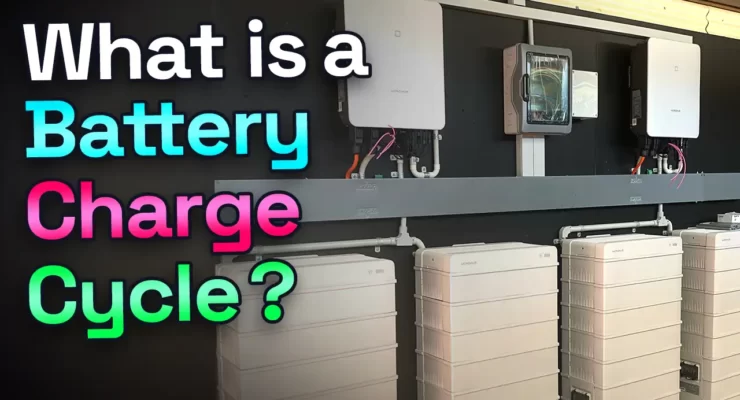
Fast read
The excess solar energy that would generally be exported to the grid is stored using solar batteries. The amount of power consumed by the home, the size of the solar panel system, and the percentage of electricity utilised during the day vs the night all affect the size of the required solar battery.
The typical 6.6 kW solar panel system generates roughly 25 kWh annually. Depending on the location, the typical family residence uses about 20 kWh of electricity daily for the average home. Therefore, the size of a solar battery should be between 10.4 and 14.4 kWh. This will cover any nighttime electricity usage that exceeds needs.
However, the battery size might need to be increased if the house contains an electric car to meet its charging requirements.
Solar battery sizing explained to you
Solar batteries allow a residential property or business to store excess solar energy. Rather than letting that energy be exported to the grid. Those electricity exports to the grid are usually rewarded via a low payment of 5 to 10 cents per kW/h. As a result, solar batteries and their size equip owners to power their residences at night with renewable energy.
Here is a rough calculation of sizing your solar battery
The sizing of a home solar battery depends on various factors. A typical family home may require a 10-13kWh solar battery to provide power at night. This is only necessary if the solar system is adequate and the panels produce surplus electricity during the day.
We come to this initial conclusion because the average home consumes about 20 kW/h per day in electricity. Therefore if we count roughly 50% consumption during the daylight hours and 50% at night, a solar battery this size will cover the needs of most homes.
Now to get into more specific individual calculations. But, first, one must examine their electricity bill and determine their average daily consumption over the past 12 months.
If your home consumes 30kW/h per day, then in a rough calculation, you would need approximately 15 kW/h of solar battery storage to be relatively self-sufficient.
Your solar panel systems need to be large in size enough to generate surplus electricity for the battery. So the sizing of the solar system, the household’s energy consumption pattern, and the solar battery’s size need to be finely aligned and tuned.
A detailed example for you
During the day, solar cells can provide 30% to 60% of the electricity used in a typical home.
Naturally, the specific details depend on how much time people spend in the home during the day.
Retirees will have a high percentage of daytime in comparison to a family, when everyone is out of the house during the day, cooking, TV watching, and washing occur at night.
The average family home uses around 20 kWh of electricity throughout the day. The average 6.6kw solar panel system produces an average of 22 kWh of electricity annually in Hobart, 24 kWh in Melbourne, and 29.5 kWh in Brisbane.
If this household were in Melbourne, only 9.6 kWh of electricity produced by solar panels would contribute to the household’s daily electricity consumption. The rest being 14.4 kW/h on average per day, will be exported back to the grid.

What does this mean
This means that 10.4kWh, of the 20 kWh average electricity use per day will need to be purchased from the energy grid to cover the night-time use. So the solar power system generates enough electricity daily to supply the family’s needs.
This is where a solar battery system is essential to make our “homegrown” renewable electricity available 24/7 when we need it.
In our sample above, we import 10.4 kWh at night and export 14.4 kWh during the day, so we have 14.4 kWh available to fill a battery. So, in conclusion, the best solar battery size for your home ideally sits somewhere between 10.4 and 14.4 kWh.
More to consider
Now one new factor to consider has emerged. This might double or even triple the solar battery size required.
This factor is the electric car. Many homes have two or even three vehicles, and most cars travel at least 50 km daily in major cities. Therefore, one would need to cater to these future EV cars’ charging needs via the solar battery.
With a need to use 12 to 18kWh to travel 100 km, a 20 to 30kWh solar battery size could supply the house at night and help charge the EVs daily.
To get all this consumption covered by the rooftop solar PV system. One would have to have a solar system that generates at least the daily household and EV charging consumption of about 40 kW/h.
So because of the EV – we have just doubled the PV system and solar battery size needs of a standard home.
You can use our output calculator here to determine your personal needs or the size of a solar system one would need to generate this amount of solar energy each day, for the majority of days in the year.
Average daily generation
Suppose we use the average daily generation of 40 kW/h as our yardstick, then in Darwin, we would need a 7.73 kW system. In Perth an 8.55 kW, in Brisbane 8.95 kW, in Adelaide 9.45 kW, in Sydney a 10.02 kW, Melbourne 10.95 kW, and in Hobart, one would need at least a 12kW solar system.
Interestingly, we would need a 50% bigger solar system in Hobart. But, compared with Darwin, it generates the same amount of energy.
So what’s the best solar battery size for me?
Your solar battery’s size has to cover at least your night-time consumption.
So one has to break down one total 24-hour electricity consumption into the daytime and night-time parts. These numbers will allow your solar installer to give you the correct solar battery size.


